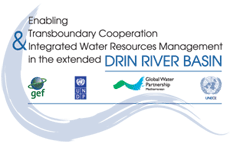Floods Insurance
A challenging and recurring natural hazard...
Floods are the most challenging and recurring natural hazard in the wider Western Balkan region and therefore also in the Drin Basin. River floods occur mainly from March to June (spring) and from September to November (autumn) in plains and lowlands. As snow melting causes spring floods, these often last longer than autumn floods, which are caused by heavy rainfall, making them more sudden with very high flows. Climate change is forecasted to increase both the frequency and intensity of flooding and droughts in the region.
Apart from climate change effects, geomorphological characteristics, hydrological features of watercourses and geotechnical formation of the terrain, flood events in the Drin Basin region are also augmented by environmental degradation factors such as continued pollution and poor waste management, as well as by factors such as improper urbanization and/or inappropriate land use.
Flooding events in riparian countries of the Drin Basin have been experienced more frequently since 2010. Socio-economic vulnerability is high due to the high (9-21%) poverty rate and unemployment, particularly in rural and mountainous areas.
“Stormwater model 2D simulation of the lower Drin Basin, Buna/Bojana sub/basin and part of the Skadar/Shkoder sub-basin, HEC-RAS 2012 and RIVERFLOW2D 2019; water levels computed between 9.7 masl and 9.85 masl.
In A.Mubi Zalaznik, A. Potokar, P. Banovec, M. Cerk (2020): Report on the Wastewater Treatment Decision Support Tool for Shkodra City Pilot Model, Anex 6; within the project Preparation of Wastewater Management Decision Support Tool In the framework of Memorandum of Understanding for the Management of the Extended Transboundary Drin Basin GEF Project “Enabling Transboundary Cooperation and Integrated Water Resources Management in the Extended River Basin”
Action for flood risk management
Risk transfer mechanisms such as risk-based flood insurance and thus the long-term flood risk financing were among the key sustainability issues to be addressed, as part of the future implementation of integrated flood risk management at the basin scale.
Responding to the needs and related provisions in the Drin MoU and in line with the Drin Strategic Action programme, the pilot activity entitled “Flood insurance in the areas of Skadar/Shkodër Lake – Buna/Bojana River, and Struga in Ohrid Lake” was implemented under the GEF Drin project. Its objective was to assess the feasibility of introducing flood/natural disasters insurance as one of a suite of flood risk transfer mechanisms for the basin and provide clear recommendations on what would be required for full development and implementation of a basin-wide insurance scheme, by undertaking studies in pilot areas which are among those at highest risk of flooding in the Drin Basin i.e. the Skadar/Shkodër, Buna/Bojana, and Struga areas.
Willingness to pay surveys was one of the tools under the activity, using focus groups meetings and individual interviews to collect relevant information on residents’ and other stakeholders’ attitude towards risk and their willingness to support/subsidize the insurance scheme. Such information helped to assess different insurance options and determine the willingness of users to pay for these as well as the willingness of the institutions to contribute in their implementation.
The activity comprised five phases of implementation:
Phase 1. Inception phase
Phase 2. Data collection and analysis of existing conditions
Phase 3: Socio-economic vulnerability assessment and characterisation of study areas
Phase 4: Willingness to pay survey of outline flood insurance scheme
Phase 5: Private Sector Willingness to contribute to/subsidise flood insurance





